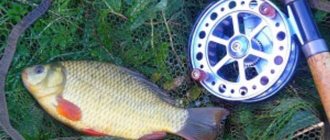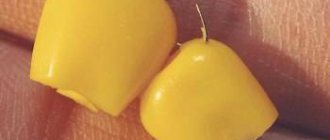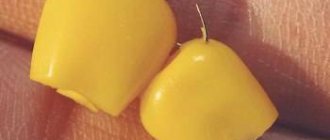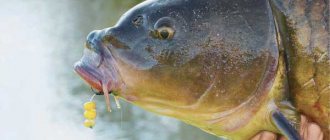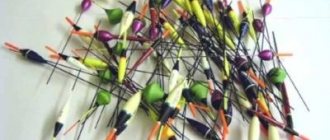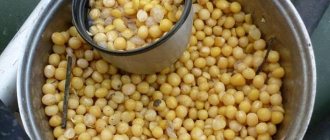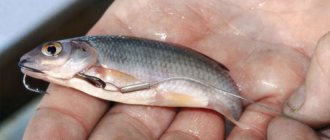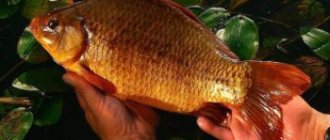Planting one grain
One grain is used when fishing for not very large sizes (roach, silver bream, crucian carp and others). If only one grain is hooked, then the hook should be small (from 16 to 20). The specific size is selected based on the size of the fish and the size of the corn grain. There are several ways to plant one grain.
Corn nozzle through
In order to attach the bait in this way, you need to insert the sting into the upper whole part of the corn grain, and, having passed the fore-end through, remove the tip from the base. When baiting through the bait, you need to try to use less force and not squeeze the bait with your fingers, otherwise there is a chance of crushing the grain. You can also pierce through from the wide side, as shown in the photo.
Nozzle through to the side
Grain Edge Attachment
With this method of baiting, the hook passes only through the skin of the grain, leaving most of the bait hanging freely. This type of bait is not suitable if you need to catch crucian carp. Most often it is used for catching carp and other fish with a large, fleshy mouth.
Because of the protruding point, a cautious fish will lose interest in such a bait as soon as it starts to taste it with its mouth and feels the sting.
Edge attachment
Hidden planting
If the goal is to catch a cautious fish, then this method of baiting is usually used. It is stuck at the top and passes over the entire area of the grain. After this, the tip is brought out and again deepens into the bait. It turns out that almost all of the forearm along with the sting are hidden in the grain, which means that the shy fish will not have the desire to spit it out at the first try.
Nozzle with hidden hook
Planting multiple grains
When planting several grains, the same methods are used as when planting one grain. If you plan to catch carp, then you can simply make a “garland” of corn, piercing it right through the side.
To give the bait a more natural look, you can use different baiting methods. For example, alternately cling to the peel and through. The chaotic arrangement arouses greater interest in the fish.
The number of grains planted depends on the size of the hook and what kind of fish you plan to catch. For example, two or three pieces are enough for crucian carp. In the case of carp, the more the better.
Placing several grains in a “garland”
Placing different baits on one hook
If the bite is not very active, the situation can be corrected by using other baits, such as maggots or a worm. Anglers usually call this bait a “sandwich.” This method has many variations. The main thing is to put on different baits randomly, with a lot of protruding parts. This way the bait will attract the attention of even the laziest fish. The weaker the bite, the more carefully you need to be careful about how exactly the bait is put on. Below are examples of the most common “sandwiches” for fishing.
Bait made from maggots and corn
Maggot is usually used when fishing for bream and others like it. However, it can also be used in conjunction with corn to add movement to the bait and therefore attract additional attention. When planting such a “sandwich”, several maggots are usually put on first. After this, a grain clings to the edge. If the size of the hook allows, then at the end all this can be pressed down with another maggot.
The main thing to remember is that the maggot is inserted with the wide end so that the main part of the body hangs down. With this method, he will live longer and will make more movements, which will have a good effect on the bite.
Sandwich with white maggots
"Sandwich" made from worm and corn
An equally effective combination for fishing is corn and a dung worm. Crucian carp are very partial to such bait, especially in late spring and early summer. Usually, starting with the worm, a few worms and a few corn kernels are put on in turn. You can also attach two grains to the forend and place a worm between them. Or simply choose your own planting method that will work well in a particular body of water.
The worm, as in the case of maggots, must be worn in such a way as not to hinder its movements, leaving most of the body hanging down.
Worm and corn bait
Reasons for using a sandwich
The main reason for using a sandwich type bait is that the bite is not active enough. After all, if the fish is hungry, then it will even bite on the remainder of the corn skin or even on a bare hook. At such moments, you shouldn’t even think about how to make the bait more attractive, it will be a waste of time. It’s another matter when the bite is almost zero. At such moments, you can start experimenting and selecting different combinations of bait. Most often, this gives noticeable results.
Hair editing
Hair rigs are most often used when fishing for carp. This is done so that when the fish bites, they do not feel the metal fore-end in their mouth. This is especially important for carp, because it doesn’t just eat, but sucks up the bait like a vacuum cleaner. One of the advantages of this installation is that the hook is completely exposed, which increases the chances of hooking a trophy. At the same time, it scares away cautious and small fish. From the name it is clear that a hair rig is, in fact, a thread tied to a hook on which the bait is attached.
Hair
The procedure for installing hair tackle
A size four to eight hook is used. To get the right hairstyle you need to follow these steps:
- The hook is attached to the leash so that a part of the fishing line about 5 centimeters long sticks out.
- A not very large loop is made at the end of the fishing line.
- Several grains are put on a thin awl with a hook at the end. They fit right through, through the side.
- The hook of the awl catches the loop, pulls it, and the corn moves from the awl to the thread.
- The grains are distributed along the length of the fishing line and fixed with a stopper (you can use a ready-made plastic one or simply insert a piece of a toothpick).
The tackle is ready for use. As was said, a small fish will not even get close to it, but a large carp or carp will suck the bait along with the hook. He will no longer be able to spit it out, because the sting will securely catch on the fleshy lip.
Hair rig for carp
Most carp anglers use a hair rig when fishing for carp, and they use corn or boilies as bait. Sports fishermen release the caught fish and, in order not to injure it too much, they use this type of gear. Sometimes she can simply break down and this allows her to survive the injury from the hook painlessly.
Hair rigging has another advantage - it ensures that the carp will not be able to spit out the bait in time, which means it will remain on the hook. The fact is that carp literally vacuum the bottom in search of food, passing all the contents through the mouth. If it discovers that it has caught a foreign body, it will try to spit it out. Unfortunately, the bait flies out, but the hook mostly manages to catch on the lower lip. The basis of this installation is that the bait (corn, boilie, etc.) is placed not on the hook, but on a nearby piece of fishing line or leash. All this installation is hidden in the bait, which is stuffed into the feeder. When fishing for carp, it is best to use a “Method” type feeder, which allows the carp to “vacuum out” the contents of the feeder.
In order to obtain such equipment, the following materials are needed:
- Cord or fishing line for the leash (lead material).
- Hook No. 5 or No. 6.
- Needle for setting bait.
- Rubber or silicone tube.
- Bait (boilies, corn), etc.
For better hooking, use stiffer materials. You can learn more about how to properly mount such equipment in the video:
After reading this article and watching the video, you can learn more about carp fishing, especially for those who are just starting to “hunt” for it. After watching the video, you can see that it is not so difficult, the main thing is desire, and great patience.
Which corn grains are suitable for planting?
You can use different corn for different baiting methods. So, only boiled is used for hair installation. The purchased one is too soft and will fall off at the first sharp cast. Otherwise, there are no strict rules; any corn can be placed on a regular hook, depending on the preferences of the fisherman. Below we will talk about the species and how they affect the bite.
Canned sweet
You can buy this at any grocery store. If you need to take corn in a can, then you should take it with the “sweet” mark on the label. The smell can attract crucian carp, carp and other fish. The most common and frequently encountered brands are “Bonduelle” and “Vernet”. But for fishing, any option, even the cheapest one, is suitable. Most fishermen believe that regular store-bought sweets are in no way inferior in quality to branded store-bought ones.
Canned food is convenient to use because the corn in them is ready for use immediately after purchase and does not require any additional processing. One of its disadvantages is that it does not sit well on the hook and can sometimes fly off it.
You can also make sweets at home. To do this, it is first left in water for two to three days. After this, the swollen grains are boiled for about thirty minutes; sugar, honey or other sweeteners are added during the cooking process. When cooking, you can check the degree of readiness by placing the corn on a hook and checking how it holds on it. When cooked, you can add vanillin or other flavorings to it. At the end, leave to infuse for a day. During this time, lactic acid is formed, which will also attract the attention of the fish.
Canned
Steamed
This type can be prepared in different ways. The first method: the grains are soaked in warm water for a day. The water is changed periodically (at least five times). The soaked grains are placed in a thermos, filling it one quarter full. At this point you can add flavoring. After this, the thermos is filled with boiling water and closed for 4 hours. The steamed corn is ready. If you don’t overexpose it, it will stick well to the sting.
The second method takes less time. First, the grains are boiled in boiling water for about ten minutes. After this, the water is drained from the pan, and the grains are poured into a thermos. Boiling water is poured into a thermos and left in this form until fishing begins. With this method, the grains are very hard and sit well on the hook. When fishing with such a bait, a very small part of the sting is exposed, so that it is easier for the fish to bite through the bait.
Steamed grains
Fermented boiled
The grains are soaked in water for a day. After they have settled, the water is drained and the corn is thoroughly washed. Water and sugar are poured into the pan in the proportion of 1 tablespoon to a liter of water. The grains are boiled in sweet water for about an hour. The water is drained from the pan, the grains are poured into a container with a narrow neck. A flavoring agent (honey, vanillin, coriander or any other of your choice) is added to the grains and the container is filled with cold water. To make fermentation go better, you can add a teaspoon of yeast. Access to air can be blocked by pouring a small amount of oil into the container. There is no need to close the container itself. The resulting mixture remains in a warm place for three to four days. Fermented boiled corn is ready. After this, it can be packaged and stored in the refrigerator. In this form it will retain its properties for about a month.
Fermented grains
Artificial
The artificial look imitates real plant grains, but, unlike them, is made of plastic. It may come straight out of the factory with a smell. If the artificial corn is odorless, the fisherman can choose the smell he wants on the spot using flavoring agents. Plastic grains hold well and have positive buoyancy. They are convenient to use on overgrown reservoirs with a muddy bottom.
Artificial bait can be used on a hair rig as a float that will lift the rest of the bait. This one can be used several times. Some manufacturers promise that the scent can last up to six hours.
Worth a try. sometimes helps
Branded
Can be found in specialized fishing stores. Sold in a large selection of scents and colors. It adheres to the tip very well and does not fly off during a sharp cast. This type is preferred by those fishermen who do not want to spend a lot of time preparing homemade bait.
Branded
Methods for placing corn on a hook: instructions
The following methods are used for planting:
- Hook installation with piercing. With this method of attachment, the sting is left open, piercing the fruit. A boilie needle is ideal. Possible options:
- Single grain nozzle. It is carefully placed and, for effectiveness, sprinkled with a flavoring agent that attracts the attention of the fish.
- Multi-grain attachment. To give the composition a natural look, it is advisable to place several kernels on the hook, to give the “dish” an appetizing smell, you can use special flavors - the choice depends solely on the preferences of the fisherman.
- Sandwich. To catch fish, you can choose a combination of kernels and animal bait, for example, bloodworms or maggots.
- Hair rig. This method is most often used for carp fishing. So, for production you will need:
- Braided fishing line.
- Hook.
- Small silicone tube.
- Needle.
- Stopper for boilies.
The installation process goes like this:
- You need to tie a loop on the braided fishing line.
- You need to put a tube on the “braid” and thread a hook.
- It is necessary to thread it so that the bend of the tip is in the opposite direction from the fishing line.
- Next, it is important to adjust the length of the hair and fix the fishing line on the hook.
- The grain should be pierced with a needle and placed on a loop of hair, and then secured with a boilie stopper.
Which hook to choose
The choice primarily depends on the size of the fish you plan to catch. For crucian carp, roach and other small fish, small ones (17-20) are suitable. If fishing is aimed at catching carp and carp of trophy size, then the hook should be larger (8-12). And the point is not that the small one cannot cope with the big fish. There are many examples of large-sized prey being caught on a small one. You can simply hang more bait on a larger hook. This will scare away small fish and, on the contrary, will increase the chances that large fish will be interested in the bait. If desired, you can also use a double hook to allow for more bait. Otherwise, a good hook should have the following properties:
- Have a sharp sting. If the point is too dull, then when baiting the bait it will simply deteriorate. Also, a dull tip reduces the chance of successful hooking.
- Made from quality materials. It should not be brittle, but not soft either.
- The forend should be thin so as not to disturb the internal structure of the bait.
Fishing hook
Advantages and disadvantages of corn
The grains of this plant have many advantages. Corn imparts a very attractive aroma to fish. It is also easier to prepare for fishing, because bait can be found in any grocery supermarket, and you can store it for a long time at home in the refrigerator. It holds well on the rig, so small fish will not be able to rip it off the hook.
The only disadvantage is that if you add too much corn to the bait, this can lead to oversaturation of the fish, which will greatly worsen the bite.
Which corn is better
To know how to put corn on a hook for carp or any other fish, you need to be able to understand the types of this plant bait. There are quite a lot of them. Fishermen use a specially prepared branded product, a regular canned product, or cook it themselves. Each of these options has the right to life.
Food
When purchasing, the jar must have the inscription “sweet” on it. There is an opinion that the product that is in a glass container is better. It is ready for use immediately after opening. You can prepare edible corn yourself. To do this, the grains are soaked for several days. After they swell, they should be boiled with the addition of honey or regular sugar until tender - approximately 40-60 minutes. At the end of cooking, you can add vanilla sugar to the container for flavor. To ensure that food retains its pleasant fish-like taste and smell, it is recommended to cook it in a cast iron container.
|
Steamed
The grains must be soaked in warm water, changing it periodically - 4 times a day will be enough. After that, they are poured into a thermos and filled with boiling water. After a few hours they are ready: quite dense and do not fly off the hook.
Artificial
This is not real corn, but an imitation made of plastic. You can give it any scent that it will retain for a long time. This type of corn stays on the hook better than natural corn and floats well in the water.
Young
This is not yet mature, milk corn, which can only be obtained at a certain period of its development. It is not too dense and has a distinct smell.
How to bait for different types of fish
Each fish attacks the bait differently. You need to set the bait based on the behavior of the fish you plan to catch. Below we will describe how to put corn on a hook when fishing for crucian carp, carp and other types of fish.
For carp
Carp are best caught using a hair rig. This is due to the fact that when he bites, he, like a vacuum cleaner, sucks in the bait and, if he doesn’t like it, spits it back out. He will no longer be able to spit out the bare hook, because it will get caught in the fleshy lip. Therefore, when fishing for carp, they use a hair rig, or at least bring the sting out.
Equipment for carp
For crucian carp
In the case of crucian carp, using hair rigs simply won’t work. Its mouth is too small for the hook and bait to fit together. When catching crucian carp, on the contrary, you need to hide the sting as well as possible so as not to arouse any suspicion in him that the bait is edible. Usually two grains are planted, in some cases one.
the tip is closed
For bream
Bream is caught in warm water. The corn must be peeled and the nozzle must be changed after each cast. When fishing in cool water, you can add maggot. Bream can also be caught using a hair rig.
To catch bream
For carp
Carp are usually caught using feeder gear, so the corn should be slightly undercooked and hard so as not to fly off when casting. Usually the carp tries the bait several times before swallowing it, so the sting must be hidden inside.
Nozzle for carp
Corn selection criteria
The reason for the popularity of the product is its cheapness and availability. For bait, such a product can be divided into several types:
- Canned.
- Boiled.
- Raw, unripe grains.
- Steamed.
- Fermented.
- Artificial.
- Fishing.
- Canned.
Canned is sold in all grocery stores, so purchasing it for fishing will not be difficult. For fishing, it is recommended to choose a jar that has the inscription “sweet” on it. Such fruits can be used immediately after purchase, because they do not require additional preparation.
You can prepare it yourself:
- Regular kernels must be soaked in water for 1-3 days and after they swell, proceed to the next stage.
- Next, you need to cook for no more than 1 hour and during the cooking process add honey or sugar and vanillin as a flavoring.
- Leave for 24 hours
The product must not be overcooked, otherwise there will be certain problems with hooking.
Boiled. In this case, the ingredient must be soaked, otherwise the cooking process will take a long time. It is recommended to soak the grains for 1-3 days in plain water or hemp starter and as soon as they swell you need to start cooking.
Honey or sugar is added to the water for taste and boiled for about an hour, in other words, until it becomes soft and not boiled. After the cooking comes to an end, they must be infused in water for another 1-2 days so that they have time to infuse. Then you need to add flavorings to the water.
Raw, unripe grains. Excellent fishing will take place on raw, unripe kernels. So, the most important moment of fishing with such a bait is to place it on the hook.
Steamed. Fruits are also used to prepare the steamed mixture. The product is steamed using the following method:
- The grains are soaked in water for a day, changing the water every 4 hours.
- In a thermos you need to pour the fruits into ¼ of the container and fill the remaining ¾ of the volume with boiling water.
- Next, you need to close the thermos with a lid and steam the product for 4 hours.
To add a piquant taste, you can use seasonings, spices and flavorings.
Fermented corn. It will take 4 days to prepare, so you need to start making it in advance.
The fermentation process goes as follows:
- The grains are soaked and boiled for 40 minutes. After the process, the water must be drained.
- Already boiled ones will need to be refilled with raw water, pour sugar into the water and add honey. Next, you need to add baker's yeast (1 kg of product - 10 grams of yeast).
- The mixture must be shaken and placed in a glass container. Pour a small layer of sunflower oil on top to prevent oxygen from entering.
The fermentation process itself goes as follows: yeast bacteria absorb the sugar in the composition and in return produce acid and alcohol. The container must be left open.
Artificial corn. The name itself says a lot. So, the composition is made of synthetic plastics. It is available in two types:
- In a jar with flavorings.
- The jar is odorless.
Fishing corn. It is sold in specialized fishing stores.
Packaged in special jars, the beans in which are colored in different colors and complemented with special aromas. Manufacturers select whole kernels of the same size whenever possible. The composition also contains additives that prevent spoilage of the product.

